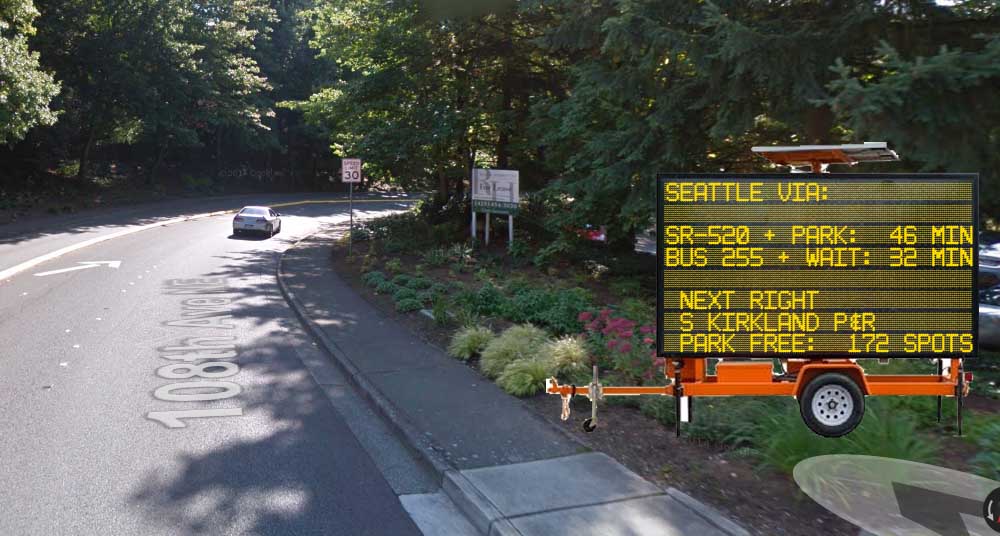The introduction of bike-share, car-share and ride-share systems has made urban transportation increasingly multi-modal enabling users to complete different parts of their journey with the mode that best suits the circumstances. If they start their trip with a personal vehicle, however, they usually do not think of it as multi-modal as there is a high perceived cost of switching modes. There must be a high benefit of leaving the vehicle somewhere for switching to a different mode to become worthwhile.
The infrastructure that provides exactly this benefit is the system of park-and-rides connected to express transit routes on dedicated right-of-way (reliable HOV/T lanes or rail). Parking and transferring to a bus might take 5-10 minutes, but often save up to 30 minutes of total travel time especially when considering parking at the destination.
Let’s consider an example: Kirkland to Benaroya Hall (Downtown Seattle)
Imagine traveling southbound on 108th Ave NE near NE 39th St, en-route to SR-520, in typical evening rush hour. The driving time is 16 minutes without traffic, but in rush hour congestion a reasonable expectation is around 36 minutes. Event parking may be tight and may require checking one or two garages taking very optimistically an additional 10 minutes. So availability at the destination would be 46 minutes later.
As an alternative, one could park at South Kirkland Park and Ride and transfer to King County Metro Transit Route 255 from there. This route uses the HOV 3+ lanes on SR-520 to bypass the usually very heavy stop-and-go traffic before the bridge and then the Downtown Seattle Transit Tunnel (DSTT) to bypass city congestion. Travel time is 25 minutes and it would take 7 minutes to make the transfer (2 minutes to park, 5 minutes on average to get on a bus – buses depart every 10 minutes). So at 32 minutes past the decision one arrives just below Benaroya Hall. That’s 30% faster–a subtraction of 14 minutes of travel time, but also no stress around navigating congestion or downtown parking.
Moreover, one has the freedom to leave any time they want, without worrying about heavy traffic right after the event. This is a typical case in which when accessing an area of high density, transit provides greater freedom than a personal automobile due to its inherent high capacity.
So how can more people benefit from the investments the region has made into high-reliability, high-capacity transit?
Advertise it
Most people driving by South Kirkland Park and Ride are not directly aware of the benefit a simple right turn can deliver unless they are everyday commute users of the facility. One approach that has been applied in other states is to use digital information signs to provide real time information of the benefit.

A sign advertising transit should provide all the specific information needed to make a decision: the complete time for each travel option and the way to switch modes. Average parking time should accounted for in the driving time (Waze collects such data) and average transfer time should be accounted for in the transit time (can include real-time wait until the next bus).
Prototyping it
Note the use of temporary movable roadside signs. This enables the Washington State Department of Transportation, King County Metro Transit, and Sound Transit to test this on a temporary basis and measure the park-and-ride utilization before and after sign placement. Only if utilization goes up would further capital expenditures be approved.
Where can this be done?
Providing such signage makes sense where significant time savings can be gained from transit. This requires the availability of two things: reliable HOV lanes and plentiful parking at a park-and-ride facility.
So here are the reliable HOV lanes, with access to park-and-rides noted in bold:
- I-5 Express Lanes (Greenlake, Northgate, and North Seattle)
- SR-520 (Evergreen Point, South Kirkland, and Overlake)
- I-90 mid-2017 (Mercer Island, South Bellevue, Eastgate, Issaquah TC, and Issaquah Highlands)
Summary
While demand for transit has been steadily increasing in the Puget Sound for many years, the congestion around events accessible by reliable transit demonstrates that there is still significant untapped ridership potential. While “build it and they will come” works to a certain extent for transit, effective location-based advertising is an avenue worth exploring. If successful, the benefits would include reduced congestion and higher return on existing investment, paving the way for more.

Anton Babadjanov
Anton has been living in the Pacific Northwest since 2005 and in Seattle since 2011. While building technology products during the day, his passion for urban planning and transportation is no less and stems from a childhood of growing up in the urban core of a small European city.


